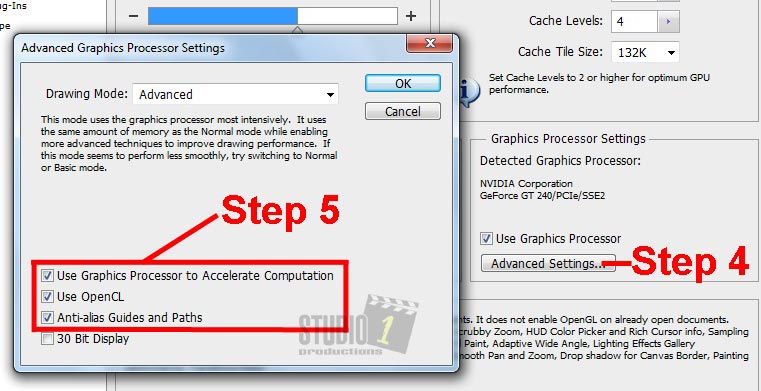How To Enable Gpu Cuda In Adobe Cs6 For Mac
I recently built myself a new computer a few months ago. I decided to treat myself with a brand new GeForce GTX 770 graphics card, which has worked wonderfully for all intents and purposes. Part of the reason I went with an NVidia graphics card was because I do video editing using. I had read that Adobe Premiere can utilize NVidia’s CUDA Cores to pre-render effects in Adobe Premiere, which cuts down on render times and makes the program run smoother overall. Sadly, when I first installed, I booted it up expecting this enormous performance from my machine. This did not appear to be the case right out of the box.
After searching around online, I found out that Premiere only has a handful of cards that have GPU acceleration enabled by default. In order to get other CUDA-enabled cards to work with Adobe Premiere’s GPU Acceleration feature, you have to go through a series of modifications. Bear in mind that just about any NVidia card that has 1 GB or more of RAM has CUDA cores in it nowadays. Whether you are getting a GeForce or a Quadro series card, you should be able to utilize CUDA cores to put extra performance into Premiere. Adobe Premiere: Steps to Enable GPU Acceleration But enough introduction, here’s how you enable GPU Acceleration for your CUDA graphics card in on Windows 7 64-bit. Make sure Premiere is closed and open up a command prompt by going to start type in cmd and press ENTER. This should open a command prompt window.
In the command prompt, type cd C: Program Files Adobe Adobe Premiere CS5 and press ENTER. NOTE: If you have CS6 or a different version, you will need to modify the file path accordingly. Now that you are looking at C: Program Files Adobe Adobe Premiere CS5 in command prompt, type GPUSniffer.exe and press ENTER. This will run the GPU Sniffer program, which will show you some detailed information about your graphics card, as seen here: 4.
Take note of where it says “CUDA device details” and more specifically, where it says “Name” and lists your card afterwards. You will need to go to C: Program Files Adobe Adobe Premiere CS5 and open the file called cudasupportedcards.txt. In this file, you will see a small list of graphics cards. You need to put a new entry in this document listing your graphics card as it shows up on the GPU Sniffer. So, for instance, mine would be GeForce GTX 770. You can see an example in this screenshot: 5.
Save the text document and open up Adobe Premiere. Create a new Project. Go to the “Project” menu Project Settings General. Under “Video Rendering and Playback” click the dropdown box where it says “Renderer” and choose “Mercury Playback Engine GPU Acceleration”. This option only shows up if the cudasupportcards document contains your graphics card. If you see this renderer option, then it means you have successfully setup Premiere to recognize your CUDA-enabled card. Premiere should use GPU Acceleration as the default renderer in all your projects.
But the easiest way you can make sure of this is to look at your Sequencer and see if there is a yellow bar near the timeline. If that bar is yellow, then it means GPU Acceleration is working. Now you should notice effects processing quicker and smoother within Premiere.

How To Enable Gpu Cuda In Adobe Cs6 For Mac Mac


How To Enable Gpu Cuda In Adobe Cs6 For Mac Free
GPU Acceleration should allow to process effects in the background while you continue to work. This should alleviate the need to constantly render your sequence in order to maintain smooth playback. I do hope this was helpful. Feel free to leave comments and feedback. Remember, and organization can save on, and more with at studica.com.
How to: Enable CUDA GPU Support for 'Unsupported Cards' in CS6 (same process as in CS5+):) for MAC Step 1. Install Cuda drivers for your Mac (im using 4.2.7) here Step 2. Open Terminal. And run GpuSniffer. Path as follows for original default installation directory, copy and paste then hit enter or change as required /Applications/Adobe Premiere Pro CS6/Adobe Premiere Pro CS6.app/Contents/GPUSniffer.app/Contents/MacOS/GPUSniffer find the right name of your VideoCard z.b „GeForce GTS 250' Step 3. Using the name of your card from the above output, i have it underlined, in my case a GeForce GTS 250, copy this exact name as we will now add it to the list of supported cards.
Using terminal still, again assuming default install directories, copy and paste then hit enter on the following. Sudo nano /Applications/Adobe Premiere Pro CS6/Adobe Premiere Pro CS6.app/Contents/cudasupportedcards.txt You will then be asked for your computer password, type it and hit enter, it will not be shown as you type FYI. You will then see the default supported cards, add your card by pasting the name you have as in Step 4, then use ctrl+x to escape, type Y to save and hit enter a couple of times to get out.
You should now be able to run Premier Pro CS6 using the CUDA GPU option you can select in Renderer as you start a new project!!
Comments are closed.